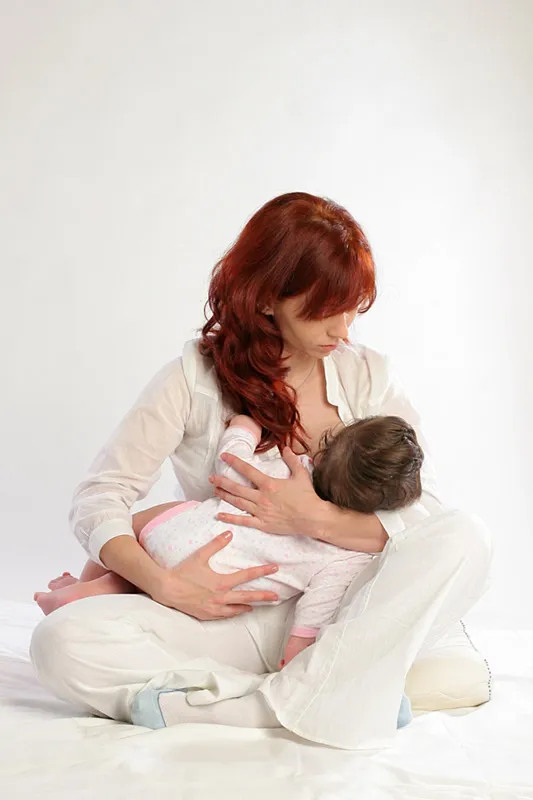How to Hold a Newborn Baby Properly (With Pictures)

- Tips to Prepare Yourself to Hold a Newborn Baby
- How Should You Pick Up a Baby?
- Different Baby Holding Positions
- How to Hold Your Baby After Breastfeeding?
- Tips for Holding a Baby in the Right Way
- How to Hold a Crying Baby?
- How to Hold Your Newborn While Bathing?
- How to Hold Your Baby When Burping?
- Common Mistakes to Avoid When Holding a Newborn Baby
- FAQs
- Infographic: Safe Baby Holding Positions
New parents are rather nervous about holding the baby as they want to ensure that the baby isn’t hurt in any way. Holding a newborn baby for the first time is a special and delicate experience that requires proper technique to ensure the infant’s safety and comfort. Newborns are fragile, with soft bones and limited head and neck control, making it essential to learn the correct way to hold them. This fear and nervousness about holding a baby can be easily overcome with a clear understanding of how babies react to being held in a certain position and zeroing in on some of the best positions that your baby is comfortable in. In this article, we will learn about the different newborn holding positions to make the experience safe and enjoyable for you and the baby.
Tips to Prepare Yourself to Hold a Newborn Baby
Before you embark on the task of holding a baby, here are a few steps you will need to follow:
1. Wash Your Hands
Babies don’t have a fully developed immune system, and germs and bacteria from an unclean hand may cause infections in the baby. Rinse your hands with some mild soap and water before you pick up the baby. Parents can also keep a sanitiser handy for emergencies.
2. Get Comfortable
Make yourself physically comfortable to leave no room for slips or mistakes. It is also essential that you are confident and calm before you pick the baby up. Also, remove things like watches or pins from clothing that may scratch the baby.
3. Choose Your Position
If you are not experienced with holding a baby, the best thing to do is figure out a comfortable position in which the baby is well cradled and supported.
4. Provide Support
Babies have a heavy neck and have little to no control of their neck muscles. Hence, it is vital that you provide adequate support to their head and neck while holding them. Babies should be supported at the neck and the head at least until they turn three months of age when they develop control of their necks.
How Should You Pick Up a Baby?
While picking up a baby, place one hand under their head and the other under their bottom to raise them up to your chest level. Always ensure to provide support to the baby’s head while you are picking up or holding him or her.

Different Baby Holding Positions
There are many ways to hold a baby, each suited for different situations, like calming them, feeding, or just cuddling. Here’s a list of some of the best positions to hold a baby.
1. Shoulder Hold
One of the most common baby holding positions, this allows your baby to listen to your heartbeat.
Lift your baby to your shoulder height with the baby’s body in a parallel position to you and allow your baby to rest his or her head on your shoulder. Support your baby’s head and neck with one hand and bottom with the other.

2. Football Hold
The football hold is a preferred feeding position for many mothers.
Provide support to your baby’s head and neck with one hand and use the forearm of the same hand to support the rest of the back. Curl your baby towards your body and let the legs extend behind you. Draw her close to your chest while feeding in this position and use the other hand to provide extra support to the neck and the head (1).

3. Lap Hold
This is a comfortable sitting position and can be used while feeding.
With your feet firm on the ground, place the baby on your lap such that the baby’s head is near your knee with face upwards. Place both your hands under the baby’s head for support and your forearms under the baby.

4. Chair Hold
Also called the ‘Hello-World hold’, this is perfect for a baby who is curious and would like to see what’s going on in the front.
Have your baby lean against your chest to provide proper head support. Place one hand on the chest of the baby and the other on the bottom, while providing adequate support.

5. Cradle Hold
One of the most natural positions of holding a baby, this position can be used to put the baby to sleep.
Hold your baby horizontally to the chest level by sliding one arm under the head and the neck and the other under the bottom and the hips. Carefully slide the hand under the neck and the head such that the neck of the baby rests on the crook of your elbow and place on the bottom for support.

6. Hip Hold
This position is recommended only after the baby is over three months of age and can support the head and neck.
Make your baby face forward and place her on your hip bone in a sitting position. Wrap your arm around your baby’s waist and hold the baby firmly.

7. Face-to-Face Hold
This position is perfect for bonding and interacting with your baby.
Provide support to your baby’s head and neck with one hand and support the bottom with the other. Hold the baby a little below your chest such that he or she is facing you.

How to Hold Your Baby After Breastfeeding?
Immediately after you feed the baby, sit the baby in an upright position and pat on the back until he or she burps. Do not bounce or move the baby too much after feeding as it may cause your baby to spit up.

Tips for Holding a Baby in the Right Way
Focus on how your baby reacts while bring held and change the position if your baby seems fussy. Here are a few tips on how to hold the baby right.
- Keep the baby’s head free enough to move and breathe.
- Maintain skin to skin contact to keep her warm and bond.
- If you’re nervous, opt to hold the baby while seated.
- Don’t hold the baby while cooking, cleaning or caring dangerous items like knives to prevent harm.
- In case you have to carry your baby for too long, try getting an infant support pillow, which is beneficial during breastfeeding as well.
- While climbing or descending the stairs, use both arms to hold the baby for added safety.
- Don’t hold the baby when you’re arguing and frustrated as you may shake the baby causing severe consequences like brain damage.
- You can use baby carriers if you have to hold the baby for long durations.
How to Hold a Crying Baby?
While there is some debate over the crying-to-sleep training method, Dr. Robert Hamilton from Pacific Ocean Paediatrics has demonstrated a position that can almost instantly stop the baby from crying. This position is suitable for babies below three months of age as after that they become quite heavy for it.

- Cross the baby’s hands across the chest and hold it in place with your hand.
- Use the same hand to support the baby’s chin.
- Place the fleshy part of your other hand on the baby’s bottom for a comfortable hold.
- Now, holding the baby at a 45-degree angle, gently swing your baby to stop him or her from crying.
How to Hold Your Newborn While Bathing?
You can make bath fun for babies by using this position to hold your baby during bath time (5).
- Place one hand on your baby’s back and shoulder and the other on the bottom as you lower your baby into the tub.
- Once you have settled the baby in the tub, you can use the hand which was supporting the bottom to wash your baby while the other hand continues to support the head and keeps it above water level.
How to Hold Your Baby When Burping?
Burping is an important step in caring for a newborn, as it helps release trapped air from the baby’s stomach, preventing discomfort and fussiness. Here are some effective positions to hold your baby when burping (3):
- Place the baby upright against your chest, with their chin resting on your shoulder. Support the baby’s bottom with one hand and gently pat or rub their back with the other.
- Sit the baby on your lap, facing sideways. Support their chest and head by placing your hand under their chin (not on the throat) and lean them slightly forward. Use your other hand to pat or rub their back.
- Lay the baby across your lap on their tummy, with their head slightly higher than their chest. Support the baby’s chin with one hand and gently rub or pat their back.
Common Mistakes to Avoid When Holding a Newborn Baby
Holding a newborn requires extra care and attention, as small mistakes can lead to discomfort or even injury. Here are a few ways how not to hold a baby:
- Not Supporting the Head and Neck: Newborns lack neck strength, so always support the baby’s head and neck when picking them up or holding them.
- Shaking the Baby: Even in play, never shake a newborn, as it can cause serious brain injuries. Always handle the baby gently (2).
- Lifting the Baby by the Arms or Hands: Never pick up a newborn by the arms or hands, as this can dislocate their joints. Instead, support the baby’s entire body, especially the head and torso (1).
FAQs
1. Can I use a baby carrier or sling for newborns?
Yes, you can use a baby carrier or sling for newborns, but make sure it is specifically designed for infants and provides adequate neck and back support. Follow the manufacturer’s instructions to ensure the baby is positioned safely (4).
2. What should I do if I feel nervous about holding my newborn?
It’s normal to feel nervous, especially as a new parent. Take your time and practice holding the baby in a seated position initially. You can also ask for guidance from a doctor. Confidence will grow with practice, and you will soon feel more at ease holding your baby.
Remember that it is essential to stay calm and confident before you pick up your baby, to keep the baby relaxed and comfortable throughout.
Infographic: Safe Baby Holding Positions

References/Resources:
1. Morse. J; 10 tips for handling and holding a newborn; University of Texas Southwestern Medical Center; https://utswmed.org/medblog/newborn-holding-tips/
2. A Guide for First-Time Parents; Nemours KidsHealth; https://kidshealth.org/en/parents/guide-parents.html
3. Baby basics: How to burp your baby; UNICEF; https://www.unicef.org/parenting/child-care/how-to-burp-baby
4. 7 Tips for Safe Babywearing; Penn Medicine Lancaster General Health; https://www.lancastergeneralhealth.org/health-hub-home/motherhood/the-first-year/7-tips-for-safe-babywearing
5. Navsaria. D; Bathing Your Baby; American Academy of Pediatrics; https://www.healthychildren.org/English/ages-stages/baby/bathing-skin-care/Pages/Bathing-Your-Newborn.aspx
Also Read:
Baby Sleeping Position – What Is Safe?
How to Protect Your Baby While Keeping Them Happy
Wonderful Ways To Keep Your Baby Safe and Protected
Rules & Tips for Visitors on How to Hold Newborn Baby?
Was This Article Helpful?
Parenting is a huge responsibility, for you as a caregiver, but also for us as a parenting content platform. We understand that and take our responsibility of creating credible content seriously. FirstCry Parenting articles are written and published only after extensive research using factually sound references to deliver quality content that is accurate, validated by experts, and completely reliable. To understand how we go about creating content that is credible, read our editorial policy here.
























